SUSTAINABILITY
Green and air-dried timbers, the ones used in traditional timber framing, can be safely said to have one of the lowest possible ecological footprints of any structural building material.
All wood can claim to score well in this respect, since it actually locks up carbon from the atmosphere into the building (for as long as the building is standing the carbon in the cells of the wood is sequestered from the atmosphere).
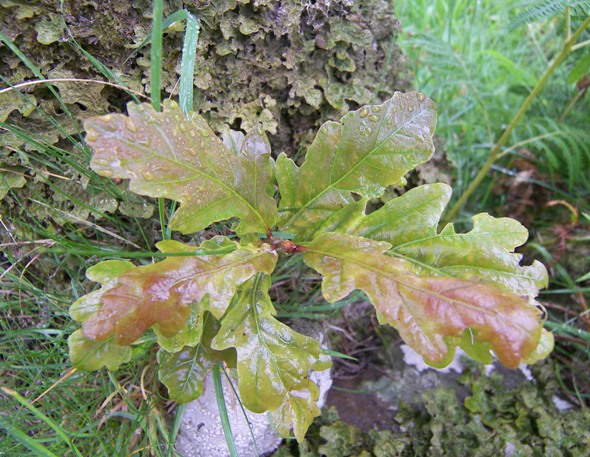
But there are additional benefits with respect to the overall ecological footprint in the case of green and air-dried timber as used in a traditional jointed timber frame:
Firstly, there is relatively little energy required for the processing of the timber since the sawn surface area of a large section frame is commonly less than half that of a conventional stick frame and it is not planed or regularized (unless it is made with a large Hundegger CNC machine when every piece must go through a gigantic four sided planer, which is not really my bag and I have not so far been involved with). Additionally, and very importantly when considering the embodied energy, it has not been kiln dried like most other wood used for building, this being a very energy intensive process.
Secondly, there is no need to treat the timbers with ecologically toxic chemicals which can leach into the environment from the wood itself or from the pressure treatment plant. Both oak and sweet chestnut contain natural tannins in the heartwood which deter both fungal and insect attack. To get a perspective on how damaging the modern timber treatments are it is interesting to note that off-cuts of pressure treated wood on building sites are classed as toxic waste and can not, by law, be burnt or even disposed of in normal landfill!
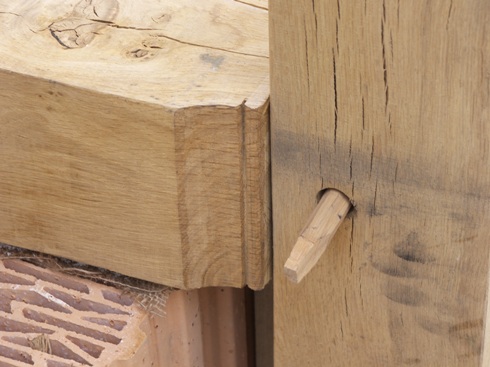
Thirdly, there is usually very little steel or other metal used in a green oak frame because most of the fixings are wooden pegs. Steel and other metals all have very high embodied energy (see page with comparison of embodied energy of traditional and engineered frames) and also create varying levels of chemical pollution in their manufacture. Steel is typically quoted as having an embodied energy at least 120 times that of locally sourced wood (for green minimally processed wood it could be more than twice this). Many people say "fair enough but steel is so much stronger that you need much less of it in a given build". Actually this is not borne out by the evidence. To quote TRADA : "It is interesting to note that while steel is over three times as strong as oak, it is ten times heavier. Thus the strength to weight ratio of clear dry oak is much superior to steel." There are mitigating variables of course, like quality, type of failure (brittle rather than ductile) and strength losses under sustained load, but well specified green oak still usually comes out on top.
Fourthly, it is eminently reusable. If the building must be dismantled one has a number of choices: the frame can be reassembled in its original form in another location, the timber can be very easily reused for other purposes, it can be used for heating in the form of firewood, or it can simply be left to rot down and compost into a healthy life giving soil.
Lastly, the use of the timbers most suited to traditional framing, particularly
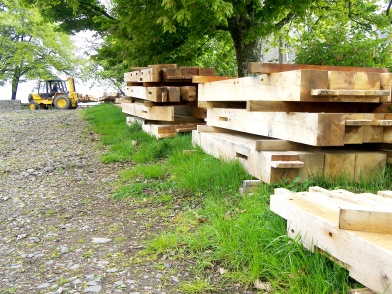 oak, in large volumes, encourages the proper management of existing broadleaf and mixed woodlands and also the planting of new ones. This is particularly beneficial because these woodlands are much more biodiverse than the large scale monocultures of Norway and Sitka Spruce used for conventional stick framed buildings, which do not support a very rich associated flora or fauna. As it happens oak is the tree which supports the highest number of associated species in Britain with, for example, an amazing 284 associated species of insect. By way of comparison the sycamore, which is a fairly new arrival on our islands, has only 5. More on this in the Permanence of Our Woodlands section down the page.
oak, in large volumes, encourages the proper management of existing broadleaf and mixed woodlands and also the planting of new ones. This is particularly beneficial because these woodlands are much more biodiverse than the large scale monocultures of Norway and Sitka Spruce used for conventional stick framed buildings, which do not support a very rich associated flora or fauna. As it happens oak is the tree which supports the highest number of associated species in Britain with, for example, an amazing 284 associated species of insect. By way of comparison the sycamore, which is a fairly new arrival on our islands, has only 5. More on this in the Permanence of Our Woodlands section down the page.In this section so far I have sought to show how great the environmental credentials of green and air-dry timbers are and I have compared them to the timbers more commonly used in the conventional building industry today. I do not wish however to give the impression that these conventional stick frames are to be judged as ecologically unsound. They may not be as good as a green oak frame but they are still up there at the top of the pile in respect of their ecological footprint. All wood can be regarded as sustainable and beats most other conventional building materials hands down in a lifecycle analysis.
The greatest stumbling block to sourcing local timber:
The default position on my part is always to use timber that is as local as possible, since transportation often ends up being the single biggest carbon debit in the construction of a green oak timber frame. Unfortunately using local timber is not always possible for a number of reasons, however there is one main culprit; time.
The biggest stumbling block to using local wood arises from the fact that, for us in Scotland, there tends to be a correlation between the closeness to the mill and the length of time it takes for that mill to cut the timber. The fact is that the few mills that cut hardwoods here are quite small and, since the traditional framing industry is growing so fast, they just can't keep up with demand, and their lead times are much longer than the bigger English and N. European mills. So, Scottish mills need more time to prepare the wood that the framer requires in order to get on with the job.
Because we are all used to a building process where materials can be sourced quite quickly, the project programme as devised by the client and their architect often does not allow for this extra lead time for sourcing the wood.
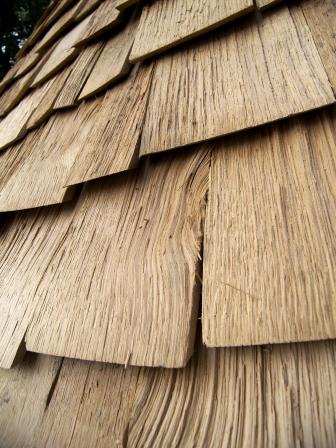 In this scenario by the time the timber can be ordered there is often rather a rush on to achieve the projected site completion date, and there is then no alternative but to choose the less ecologically sound option of ordering it from one of the big mills who can cut it more quickly, but who are located further away . In this way the road miles are greatly increased.
In this scenario by the time the timber can be ordered there is often rather a rush on to achieve the projected site completion date, and there is then no alternative but to choose the less ecologically sound option of ordering it from one of the big mills who can cut it more quickly, but who are located further away . In this way the road miles are greatly increased.Clients and architects should bear in mind that before the timber order can be done the engineering calculations must have been issued, the building warrant approved and all design variables agreed between client, architect and framer. In other words timber ordering is at the very end of the design process. And also that after the timber is ordered most changes to the design will have potentially very expensive consequences so the design must be set in stone (or should we say set in wood?)
So if the plan is to use local timber then the only solution at present is to allow for this time lag in the programming of the project, preferably right from the very beginning, and if there is a site completion date to achieve that can not be changed then the whole commissioning, design, planning/warrant, and engineering process must be brought forward by a sufficient amount of time to allow for the use of local timber.
This extra time allowance varies depending on the degree of 'localness', so it need only be a few weeks if the timber required is simply to be Scottish say, but if it is to be from the clients own standing trees it could be a question of months. I can advise on each individual project if I am approached at an early enough stage to make the necessary enquiries and other assessments of the situation. For a more generalized overview of the usual stages in the programming of a project see the 'programme' sub-page in 'the process'.
In Summary; as it is they who initially set a start date for the project, the client and their agent or architect have to be ready to allow for this constraint to the programming of the project if they want to be sure to get a frame made of local green timber, which is, after all, one of most ecologically sound structural building materials available to us today.
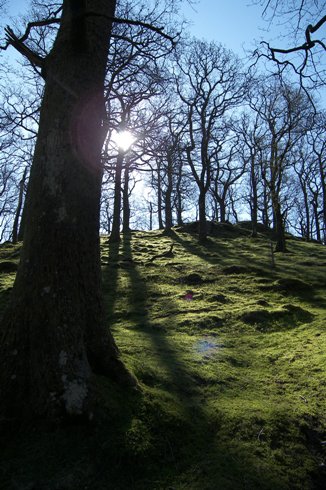
The permanence of our woodlands.
The question is sometimes asked whether the resurgence of green oak framing as a building method is depleting our forests and woodlands.
The answer is that this is mostly not the case. There is apparently a small percentage of oak sourced from old growth forest in former soviet block countries like the Ukraine, where the felling may be damaging irreplaceable ecosystems, and replanting may not be taking place. Anecdotal evidence suggests that this is currently happening and it is difficult to trace, unless a proper chain of custody scheme is in place, because the timber is often extracted and transferred to mills in Western Europe, where this practice is not allowed, and then milled there. So many people who think they are buying western European oak are actually buying this less than sustainably sourced timber. This makes more of a case than there has ever been before for sourcing as much timber as possible locally.
The situation if the timber is genuinely European is completely different.
One reason for this is that the felling of trees in Britain, and as far as I know in all European countries, is properly regulated with replanting or natural regeneration being the expected outcome. The replacement of existing trees is guaranteed, because the woodlands they are taken from are areas designated officially as “woodland” in the land registry and felling licenses require this replacement.
The unexpected and rather counter-intuitive fact is that the use of wood actually encourages the retention of woodlands. The real problem with tree c
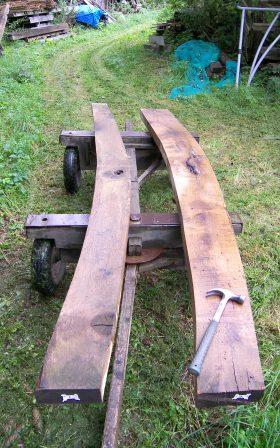 over, in Britain at least, is change of use under the planning laws which can result in woodlands becoming arable or grazing land. But what is the driver of such changes?
over, in Britain at least, is change of use under the planning laws which can result in woodlands becoming arable or grazing land. But what is the driver of such changes? Usually it is the fact that there is no longer a sufficient value ascribed to the products of that woodland so the landowner decides to apply for a change of use. The only thing that is likely to help to prevent this happening is if the value of trees remains high for some reason. Of course this value can come from all sorts of things, for example I have read recently that some believe we can thank the pheasant shooting fraternity for the permanence of many of our smaller woodlands due to the cover the trees provide for the birds as they grow to maturity. Obviously if the trees themselves are worth more then there will be even more reason for the woodland to be preserved. The trees are of course felled at regular intervals but they will always be replaced because it will be in the landowner’s interests to do this.
So in fact the use of more timber in buildings ensures that, by raising the value of that timber, more of our woodlands remain as woodlands. Using more wood means more trees!
Indeed traditional framing methods are of particular value in this respect because a greater number of the trees in a given woodland are useful to the framer. Timber usually classed as 'low quality' (eg. knotty or curved pieces) are fine in large sections framed up by a carpenter experienced in traditional methods. The kind of timber quality that we can use, especially the curved sections, are usually sold as firewood at best but become much more valuable when they are destined to become p
The retention of woodlands, and the management of them for the production of species and quality of trees useful to the framer, is happening to some extent in Britain at the moment, but mostly only in the case of large and medium sized woodlands. There is unfortunately, a major hurdle to bringing these benefits to smaller woodlands which is to do with their economic viability. The problem is in making the timber from these smaller woodlands available to the supply chain because there is not a very well developed structure in place for making these trees worthwhile to the buyers from the big mills. This is not insurmountable, some good work is being done by charities and others to bring together networks of woodland owners in the hope of creating economies of scale, and if there is some change for the better we could see a lot more timber coming on stream for business usage, some of it for building.
In the meantime however, use can be made of this resource by doing it ourselves, using mobile sawmills to mill up timber for specific projects, thereby, one can hope, raising the value of these smaller woodlands even if the buyers from the big mills are not interested.
And in this way we will be ensuring that landowners appreciate and manage their native woodlands, and populate them with a variety of beneficial species ensuring rich and biodiverse ecologies.
Finally a note on the FSC (forest stewardship council) scheme and other chain of custody schemes. These schemes are a laudable attempt to prevent damaging logging practices in countries which do not have stringent legislation or sufficient enforcement to stop the loggers. In Britain however the situation is different; You can not fell a tree without a felling license let alone any large area of woods and people do not generally get away with it. What landowners can do is to apply for change of use from woodland to agricultural land, and as I outlined above this is how losses in woodland cover are usually incurred.
Now if we return to look at the small woodlands, which are already most at risk because of the lack of commercial viability, we find that the certification schemes are potentially making the situation worse. The problem begins with the fact that now that more and more projects are requiring certified timber, there is beginning to be a market skewed in favour of it.The FSC (or similar) timber commands a premium. But the small woodland owner can not afford certification, it is too expensive. The result is that he sees the value of his timber drop, despite the fact that he is required by law to manage his woodlands properly anyway, FSC certification or not! Unfortunately he may well consider turning h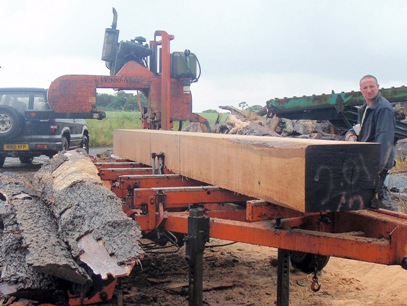 is unprofitable woodland into grazing or arable land.
is unprofitable woodland into grazing or arable land.
The moral of the story is that a requirement for certification, when ordering European and especially British timber, may be doing more damage than good, by discouraging the retention of our rich tapestry of small, diverse woodlands which are so particularly ecologically valuable. With woodlands, either we use them or we lose them.
In my opinion the best course of action is to source as locally as possible, allowing plenty of extra time in the project programme (ie. bring the commissioning and design forward), and consider each case carefully when specifying FSC certificated timber.
In the meantime however, use can be made of this resource by doing it ourselves, using mobile sawmills to mill up timber for specific projects, thereby, one can hope, raising the value of these smaller woodlands even if the buyers from the big mills are not interested.
And in this way we will be ensuring that landowners appreciate and manage their native woodlands, and populate them with a variety of beneficial species ensuring rich and biodiverse ecologies.
Finally a note on the FSC (forest stewardship council) scheme and other chain of custody schemes. These schemes are a laudable attempt to prevent damaging logging practices in countries which do not have stringent legislation or sufficient enforcement to stop the loggers. In Britain however the situation is different; You can not fell a tree without a felling license let alone any large area of woods and people do not generally get away with it. What landowners can do is to apply for change of use from woodland to agricultural land, and as I outlined above this is how losses in woodland cover are usually incurred.
Now if we return to look at the small woodlands, which are already most at risk because of the lack of commercial viability, we find that the certification schemes are potentially making the situation worse. The problem begins with the fact that now that more and more projects are requiring certified timber, there is beginning to be a market skewed in favour of it.The FSC (or similar) timber commands a premium. But the small woodland owner can not afford certification, it is too expensive. The result is that he sees the value of his timber drop, despite the fact that he is required by law to manage his woodlands properly anyway, FSC certification or not! Unfortunately he may well consider turning h
The moral of the story is that a requirement for certification, when ordering European and especially British timber, may be doing more damage than good, by discouraging the retention of our rich tapestry of small, diverse woodlands which are so particularly ecologically valuable. With woodlands, either we use them or we lose them.
In my opinion the best course of action is to source as locally as possible, allowing plenty of extra time in the project programme (ie. bring the commissioning and design forward), and consider each case carefully when specifying FSC certificated timber.
J. Rose Carpentry environmental credentials:
Environmental issues have always been close to my heart so having an environmentally benign way of making a living is very important. I am lucky to work with a material that so exceptionally fulfills this requirement and to be building structures that also do so. But this aim of reducing environmental impact really should not stop there, wit
To this end I have made a number of choices that I hope will help such as:
I do not heat the workshop. If I ever get round to it I may install a wood burning stove but for now I’m doing fine by just being well wrapped up. There is also plenty of natural light. The net result is that over the last two years I have used only 1.9 Kwh/m2/yr of primary energy (average british house uses 280 Kwh/m2/yr !) so very little added embodied energy in the clients timber.
I have a small van which I run on a biodiesel mix as often as I can (unfortunately not always, it's not easy being green!). I also have a responsible driving policy which saves a surprising amount on fuel consumption.
I cycle to work as much as I can and if travelling further afield never fly but use other forms of public transport.
My bank, telephone, electricity, insurance, break down policy etc. are all with ethical providers.
I use local and ethical suppliers wherever I can.
I try to encourage eco design in the projects I’m involved with and recommend suitable detailing and ecological building products.
Does all of this end up costing the client more? Strangely, as far as I can tell, there doesn’t seem to be much difference in the cost of proceeding as above, since some of the measures actually save money and so everything balances out.
.............................................
Finally I would like to quote Biff Vernon, a regular contributor to the Green Building Forum (an excellent source of up-to-date information on ecological building issues) who said:
”Timber is great. There is nothing else with its strength to weight ratio that grows on trees!”
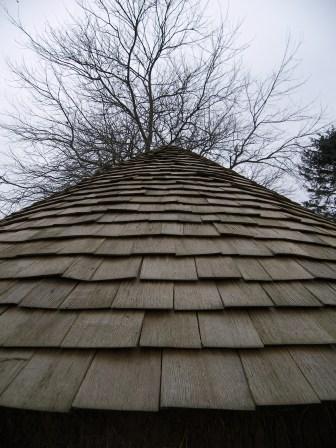 J. Rose Carpentry
J. Rose Carpentry